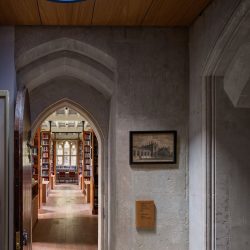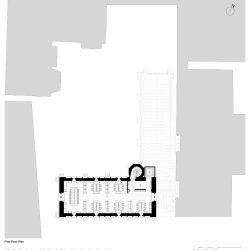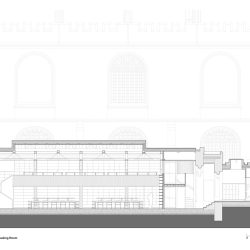
Nex . Donald Insall Associates . photos: © Will Pryce
Renewing one of George Gilbert Scott’s most accomplished works at the University of Oxford, a comprehensive refurbishment of Exeter College Library has combined a sensitive restoration programme with thoughtful contemporary interventions, and delivered transformative improvements to the library’s study spaces and accessibility.
Nex was invited to participate in a design contest to oversee the library refurbishment in 2019 and teamed up with Donald Insall Associates to win the competition. The completed project is the fruition of four years of collaboration informed by a shared recognition of the building’s historic significance, with Nex— leading the overall design vision, new alterations and design co-ordination, and Donald Insall Associates overseeing the repair of historic fabric.
Exeter College Library was constructed in 1857 by George Gilbert Scott. The library is one of several works by Scott at the college, and its neo-gothic character and detailing presages later works such as St Pancras Station in London. Its setting overlooking the Rector’s Garden in the historic heart of the college is one of the most sensitive in Oxford: the library itself is Grade II listed and sits next to the 17th century walls of Convocation House, the Grade I listed historic court room of the Bodleian Library, separated only by a sliver of ground between buttresses.
The library is arranged as a two-storey range with an adjoining lower annex in an L-shaped formation. Over the years it had become increasingly cramped and dated, and so less able to meet students’ needs. A priority for the redevelopment project was the creation of additional study space for students, alongside improvements to the building’s circulation, access, environmental performance, and services. Conservation of the building envelope was also badly needed, and Donald Insall Associates oversaw the repair of stone ashlar, windows and roofs, alongside repairs to historic bookcases within the library itself.
The library’s new main entrance replaces a door that had opened directly into the reading rooms and resulted in disruption to those trying to study, as well as significant heat loss. Framed by new arches carved of Clipsham stone to echo the surrounding historic masonry, the new entrance incorporates a draught lobby with WC and locker facilities. A secondary entrance at the north end of the annex enhances flexible movement through the building and provides an emergency exit.
Within the library, we carefully balanced the retention and repair of historic fabric with thoughtfully considered new interventions. With no construction drawings to work from, a thorough investigation of the building’s fabric and study of Scott’s wider works informed our design. On the ground floor of the main range, steel beams added in the 19th century to reinforce the range floor have been replaced with a new hidden structure, allowing the original ceiling design to be fully revealed once again.
The key to unlocking the tight spaces of the existing building and improving accessibility is a discreet single storey structure, tucked between the library and the party wall of Convocation House. Easily overlooked, the ‘Link block’ had been much altered over the past two centuries and was most recently used as a garden store and strongroom. We saw this as a pivotal opportunity: using the space alongside a gap between the Bodleian’s buttresses to create a new entrance to both wings of the library and inserting a new staircase and lift that make the library fully accessible for the first time.
Great care was taken to integrate this new element within the library’s historic fabric: the only external clue to its presence is a custom-made cast-iron cladding – inspired by Scott’s leadwork on the College Chapel campanile. The circulation space works hard – a new lift shaft is nestled behind an existing stair turret, and new rooflights bring toplight in while also revealing unexpected views of the building’s exterior, the neighbouring Bodleian, and the sky overhead.
In the annex, a 1950s mezzanine floor bisected Scott’s gothic tracery, resulting in an uninviting lower level. Here, we lowered the ground floor level to improve the space’s proportions, restored the windows to their full height, and replaced the full width mezzanine with a finely crafted and sculptural timber balcony.
This 14m cantilevered structure extends like a bookshelf balcony to exactly half the width of the room: a daring structural intervention that sits comfortably within its Victorian context, revealing the dramatic full height of the space, and providing valuable added study spaces for students.
New clerestory windows within a replacement roof, are an interpretation of Scott’s design approach to admitting daylight based on the ticket hall at St Pancras: they replace a series of unsympathetic rooflights inserted in the 1950s.
The joinery fully integrates all new services such as heating, lighting, storage and acoustic insulation, and a pair of secret doors into two compact behind-the-scenes spaces. Careful programming and off-site construction – including the use of prefabricated hardwood panels on the lift shaft and partial pre-construction of the mezzanine – helped to reduce construction time on site and disruption to students.
A series of new fixtures and fittings show the careful fusion of old and new, and an emphasis on craftsmanship that continues the architectural tradition of Scott and his peers. The extensive use of oak joinery is evocative of traditional library spaces, yet with a distinctly contemporary character: for instance, in the main range where cluttering bookshelves were replaced with new desks and under desk book storage.
On the first floor, a new timber box is a ‘pop up’ fire compartment that can protect people in the event of an emergency.
The library’s restored windows contain stained-glass roundels, designed by Edward Burne-Jones, and made by William Morris’s factory: an irony given Morris’s later opposition to Scott’s work.
Nevertheless, their pioneering glass craftsmanship finds new echoes: for instance, in new light fittings that use different types of glass to create different atmospheric effects, and in specially commissioned dichroic glass fins placed in the rooflight of the new circulation spaces.
The project was completed on-time and on-budget in Spring 2024.
_


























